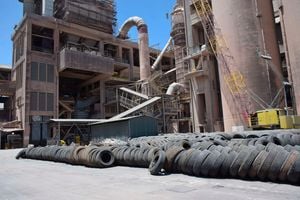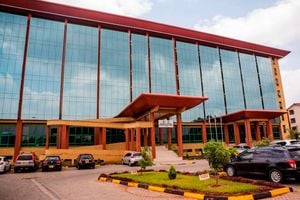
Botswana's President Mokgweetsi Masisi addresses a press conference to concede defeat after the October 30 general elections, where the Botswana Democratic Party (BDP) lost elections to the opposition coalition Umbrella for Democratic Change, in Gaborone, Botswana November 1, 2024.
Botswana’s independence party, the Botswana Democratic Party, just got “Kanu-fied”. It lost power in a country it had led for 58 years since independence, in much the same way Kenya’s independence party Kenya African National Union (Kanu) did in December 2002, after 38 years in office.
There are similarities, and big differences, between early post-independence Kenya and Botswana. Counting his time as Prime Minister, Kenya’s founding father Jomo Kenyatta died in office on August 22, 1978, after 15 years at the helm. Counting his tenure as PM, Botswana’s founding father Sir Seretse Khama died in office on July 13, 1980, after 15 years as the country’s leader.
Kenya and Botswana are among a handful of African countries that escaped military rule in the 1970s, 80s, and 90s. They are also among the only six that professed some version of capitalism and didn’t toy with socialist or revolutionary political models.
From there, they diverged and went very different ways. Botswana remained a multiparty state and maintained a reasonably honest and meritocratic system. Kenya descended into patronage politics and became a kleptocracy – albeit a functioning one. Kanu and BDP’s political demise, though happening at different times, also had similarities. Kanu lost power to the Mwai Kibaki-led opposition National Rainbow Coalition (Narc) in December 2002 elections. It won only 64 out of the 212 elected seats in the National Assembly, a loss of 43 seats from its previous count of 107 seats in the 1997 election.
In that 1997 election, Kanu had enjoyed a recovery after being battered by Kenya’s relentless democracy and multiparty movements of the time — in December 1991, President Daniel arap Moi and the ruling Kanu buckled and allowed for the restoration of multiparty democracy by repealing article 2A of the Constitution.
Regional differences
In the December 1992 election that followed, Kanu won 100 of the elected 188 seats in Parliament, with the opposition bagging 88. In 1997, it increased its share to 107. By contrast, by the time the votes from the October 30 election had been counted, the BDP was out cold in the red corner of the ring. It secured only four parliamentary seats, placing last. Perhaps they can take comfort from knowing that they did far better than SADC peer Mauritius, where results Monday evening from a weekend election left Prime Minister Pravind Jugnauth’s Lepep Alliance with zero of the 62 directly elected seats in Parliament. Southern African voters can be vicious.
Unlike the picture in East Africa, however, the gracefulness with which both Masisi and Jugnauth acted in defeat was impeccable. These regional differences are intriguing. At 58 years in power, the BDP was Africa’s second-longest continuously ruling party, after Tanzania’s Chama Cha Mapinduzi (Revolutionary Party) which has been in power for 62 years now, including in its early life as Tanu.
Algeria's authoritarian ruling National Liberation Front (FLN), would have claimed a tie with CCM or second with BDP since it has been in power since the country gained independence from France in 1962. However, FLN’s continuous dominance was significantly challenged in the transition to multi-party politics post-1989, and it has had to form coalitions with other parties since 2007. Effectively, it had only 46 years of ruling the roost alone the way CCM is doing, and BDP did for 58 years.
The BDP, however, unlike CCM, remained a liberal and democratic party. CCM, as its name suggests, fashions itself as a revolutionary party and ruled as a one-party dictatorship for 15 years until 1992. It still rules and treats the opposition like an old-school single party, except in appearances.
Million registered voters
Botswana’s case suggests that in mainland Africa, in addition to history and social and cultural dynamics, there are physical factors affecting democratic outcomes. The population of Botswana is just over 2.7 million, about the same today as Kiambu, Kenya’s second most populous county. However, Botswana is marginally bigger in land size than Kenya. It has a total area of approximately 581,730 square kilometres, although a large part of it is desert, compared to Kenya’s 580,367 square kilometres. Kiambu County and Botswana both have just over one million registered voters. Imagine an empty Kenya, with only the people of Kiambu scattered all over it!
Perhaps because the people are not tripping too much over each other’s toes, and the fact that nearly 80 per cent of Botswana comprises Setswana-speaking people, both a consensus and a herd effect are easier to form. Some of the same dynamics can be seen in Namibia, a much bigger country than both Botswana and Kenya, at 824,292 square kilometres, but has a slightly smaller population than Kiambu. Its politics is relatively mild too, and the ruling SWAPO might also suffer a shock at elections next month.
The structure of the early independence economies also seems to be important and could explain why, for example, Kenya differs from its regional neighbours. This is particularly when it comes to the nature of political transition, and whether or not voters will be shot and killed by police if they protest too much. A minimum free economic regime history seems to be good for democracy.
The author is a journalist, writer, and curator of the “Wall of Great Africans”. X(Twitter)@cobbo3









